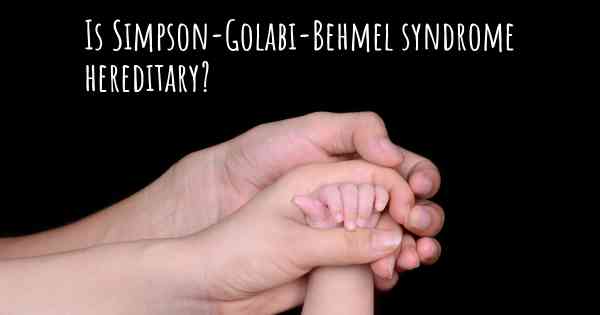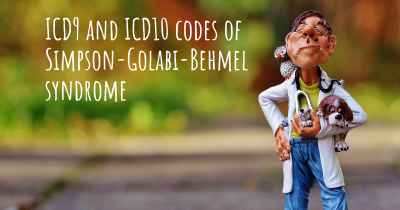Is Simpson-Golabi-Behmel syndrome hereditary?
Here you can see if Simpson-Golabi-Behmel syndrome can be hereditary. Do you have any genetic components? Does any member of your family have Simpson-Golabi-Behmel syndrome or may be more predisposed to developing the condition?

Simpson-Golabi-Behmel syndrome (SGBS) is a rare genetic disorder that primarily affects males. It is characterized by a wide range of physical and developmental abnormalities. The syndrome was first described in the medical literature in the 1970s by three different physicians: Simpson, Golabi, and Behmel, hence the name.
Causes and Inheritance:
SGBS is caused by mutations in the GPC3 (glypican 3) gene, which is located on the X chromosome. This gene provides instructions for producing a protein that plays a crucial role in regulating cell growth and division during embryonic development. Mutations in the GPC3 gene disrupt the normal functioning of this protein, leading to the characteristic features of SGBS.
SGBS follows an X-linked recessive inheritance pattern. This means that the gene mutation responsible for the syndrome is located on the X chromosome, one of the two sex chromosomes. Females have two X chromosomes (XX), while males have one X and one Y chromosome (XY). Since the GPC3 gene is located on the X chromosome, males are more commonly affected by SGBS.
In most cases, SGBS occurs sporadically, meaning it is not inherited from the parents. The gene mutation typically arises as a random event during the formation of reproductive cells (eggs or sperm) or early embryonic development. However, there have been rare instances where SGBS has been inherited from an affected mother who carries the gene mutation on one of her X chromosomes.
Signs and Symptoms:
SGBS is associated with a wide range of physical and developmental abnormalities, which can vary in severity among affected individuals. Some of the most common signs and symptoms include:
- Overgrowth: Individuals with SGBS often exhibit excessive growth before and after birth. This can result in macrosomia (large body size) and increased birth weight.
- Facial features: Facial abnormalities are a hallmark of SGBS and can include a broad nasal bridge, wide-set eyes, a prominent forehead, a wide mouth, and a large tongue.
- Organ abnormalities: SGBS can affect various organs, leading to conditions such as heart defects, kidney abnormalities, and gastrointestinal malformations.
- Intellectual disability: Many individuals with SGBS have some degree of intellectual disability, ranging from mild to severe.
- Skeletal abnormalities: Skeletal defects, such as extra fingers or toes (polydactyly), joint abnormalities, and spinal abnormalities, may be present in individuals with SGBS.
Diagnosis and Management:
Diagnosing SGBS can be challenging due to its rarity and the variability of symptoms. A thorough clinical evaluation, including a detailed medical history and physical examination, is typically the first step. Genetic testing can confirm the diagnosis by identifying mutations in the GPC3 gene.
There is currently no cure for SGBS, so treatment primarily focuses on managing the symptoms and associated complications. A multidisciplinary approach involving various medical specialists, such as geneticists, pediatricians, cardiologists, and orthopedic surgeons, is often necessary to address the diverse needs of individuals with SGBS.
Treatment options may include:
- Surgical interventions: Depending on the specific abnormalities present, surgical procedures may be required to correct heart defects, skeletal abnormalities, or other organ malformations.
- Physical therapy: Physical therapy can help improve muscle strength, coordination, and mobility, which may be affected in individuals with SGBS.
- Speech and occupational therapy: These therapies can assist in addressing speech delays, intellectual disabilities, and improving daily living skills.
- Regular monitoring: Regular check-ups and monitoring of organ function are essential to detect and manage any potential complications associated with SGBS.
Conclusion:
Simpson-Golabi-Behmel syndrome is a rare genetic disorder primarily affecting males. It is caused by mutations in the GPC3 gene and follows an X-linked recessive inheritance pattern. While most cases occur sporadically, there have been rare instances of inherited SGBS. The syndrome is characterized by a wide range of physical and developmental abnormalities, including overgrowth, facial features, organ abnormalities, intellectual disability, and skeletal defects. Diagnosis is challenging but can be confirmed through genetic testing. Treatment focuses on managing symptoms and associated complications through a multidisciplinary approach. Ongoing research and advancements in genetic testing may lead to improved understanding and potential therapeutic interventions for individuals with SGBS in the future.








